Snake Stories from the Jungles of Costa Rica
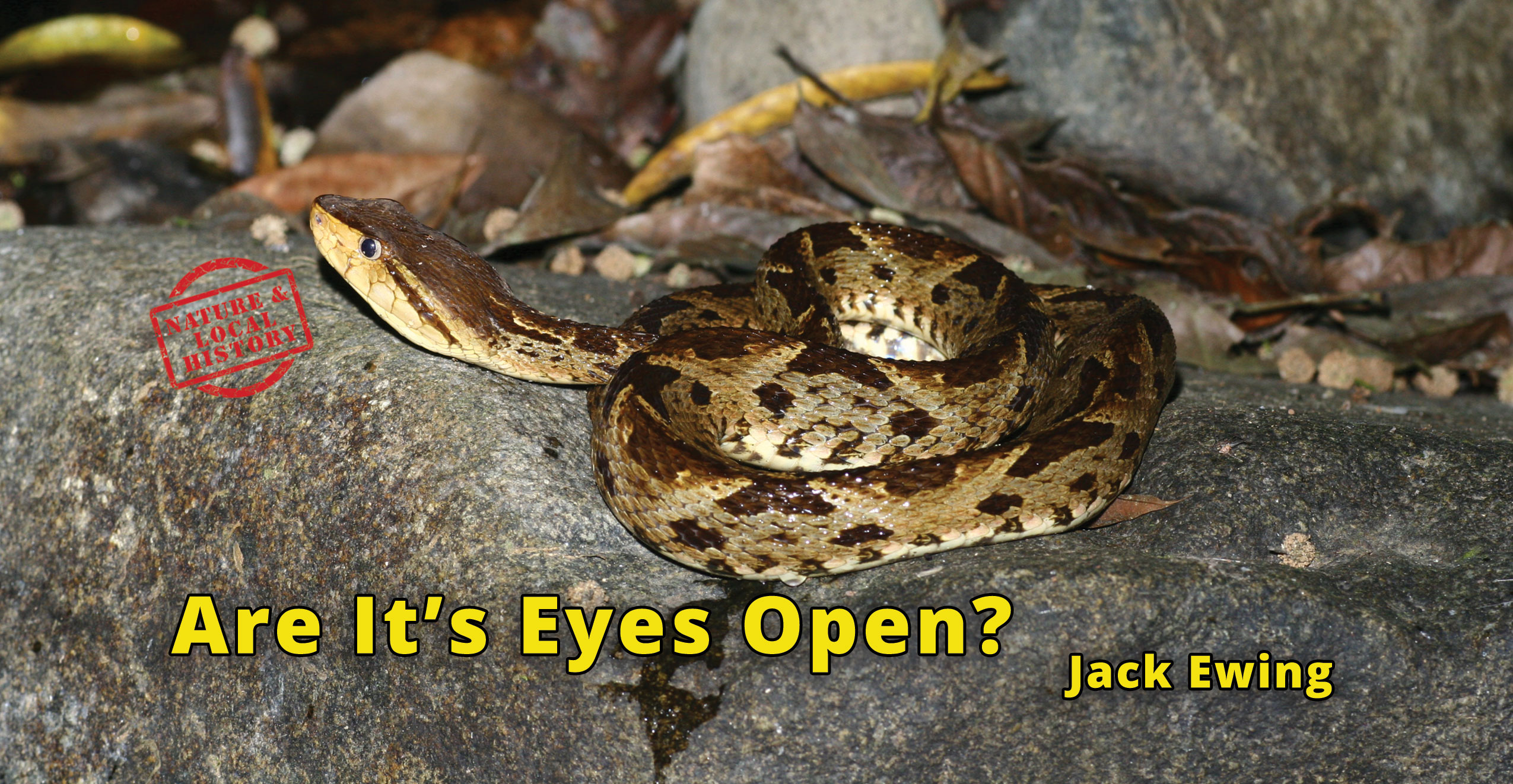
Are it’s Eyes Open? – Jack Ewing
One day, just as the sun was peeking over the mountain tops, I was hiking up a hill on a narrow trail in the dim morning light with a friend. “Hold it”, he cautioned, grabbing my arm. “Something’s up there”.
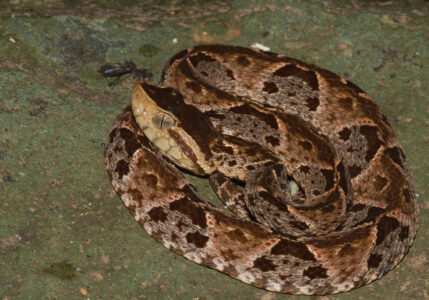 “I saw it too. It’s right there”, I pointed. Juan hastily dug a flashlight out of his backpack and shined it where I pointed. Right in the middle of the trail, coiled and posed to strike was a terciopelo viper (Bothrops asper). Normally we would have just gone around it and left it alone, but the trail was cut into the side of a hill with a steep upward slope to the left and an equally steep downward slope to the right. I found a long, forked stick and nudged it, assuming it would move out of the way. To our surprise, it attacked. While holding it off with the stick, we retreated backwards on the uneven trail with an occasional stumble. A fall would have been disastrous. It finally quit lunging at us, crawled off the trail, down the hill and let us pass. We both let out audible sighs of relief. It was a good sized terciopelo, about a meter and a half long and as big around as my wrist. Holding it away with a stick had been quite a tussle.
“I saw it too. It’s right there”, I pointed. Juan hastily dug a flashlight out of his backpack and shined it where I pointed. Right in the middle of the trail, coiled and posed to strike was a terciopelo viper (Bothrops asper). Normally we would have just gone around it and left it alone, but the trail was cut into the side of a hill with a steep upward slope to the left and an equally steep downward slope to the right. I found a long, forked stick and nudged it, assuming it would move out of the way. To our surprise, it attacked. While holding it off with the stick, we retreated backwards on the uneven trail with an occasional stumble. A fall would have been disastrous. It finally quit lunging at us, crawled off the trail, down the hill and let us pass. We both let out audible sighs of relief. It was a good sized terciopelo, about a meter and a half long and as big around as my wrist. Holding it away with a stick had been quite a tussle.
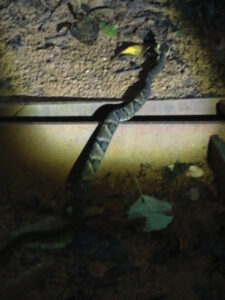 I decided to post the story on Facebook. The theme of the post was that it was the first time I had seen a terciopelo chase someone, and it brought several comments from friends who had had similar experiences. One woman said that a terciopelo once chased her dog up the front steps and struck just as the pooch zipped across the threshold, and she slammed the screen door. The snake’s nose hit the screen.
I decided to post the story on Facebook. The theme of the post was that it was the first time I had seen a terciopelo chase someone, and it brought several comments from friends who had had similar experiences. One woman said that a terciopelo once chased her dog up the front steps and struck just as the pooch zipped across the threshold, and she slammed the screen door. The snake’s nose hit the screen.
A herpetologist friend who lives near the rainforest and spends lots of his time there looking for amphibians and reptiles, said that he had been chased on rare occasions.
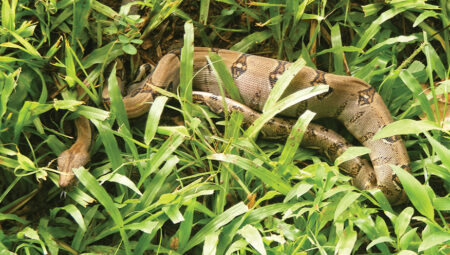 I have a great deal of respect for campesinos (country people) and always listen carefully to what they tell me about nature. Some of their “knowledge” I would classify as superstition, but much of it nothing short of ingenious. On a different occasion I was with Juan, and he spotted a very large terciopelo, close to two meters long and as big in diameter as my bicep, coiled up about five steps from the trail where we were walking. Its head was clearly visible. We admired it and talked in low voices for a few minutes when suddenly its eye opened. “It’s awake now. We need to leave”, Juan said. Knowing that I sometimes like to dither near interesting things, he insisted, and down the trail we went. He didn’t want to risk angering the snake. Later Juan explained to me that a sleeping terciopelo is not dangerous, but awake it is a good idea to give it plenty of space. I believe he is correct. Once on a guided hike with some visitors to Hacienda Barú I leaned against a tree and waited while they took photos of leaf-cutter ants. When they were ready to go the 16-year-old daughter pointed at my feet and asked, “What kind of snake is that”? Startled, I looked down to see an extremely well camouflaged terciopelo coiled and almost touching my right foot. Its eyes were closed. If it hadn’t been for the girl, I never would have known it was there. Another time one of the Hacienda Barú guides was on his hands and knees in the jungle peering into a hole looking for frogs when he moved his hand and felt something scaly under his fingers. Yanking his hand away quickly he realized to his horror that the scaly surface belonged to a coiled terciopelo. You guessed it. Its eyes were closed.
I have a great deal of respect for campesinos (country people) and always listen carefully to what they tell me about nature. Some of their “knowledge” I would classify as superstition, but much of it nothing short of ingenious. On a different occasion I was with Juan, and he spotted a very large terciopelo, close to two meters long and as big in diameter as my bicep, coiled up about five steps from the trail where we were walking. Its head was clearly visible. We admired it and talked in low voices for a few minutes when suddenly its eye opened. “It’s awake now. We need to leave”, Juan said. Knowing that I sometimes like to dither near interesting things, he insisted, and down the trail we went. He didn’t want to risk angering the snake. Later Juan explained to me that a sleeping terciopelo is not dangerous, but awake it is a good idea to give it plenty of space. I believe he is correct. Once on a guided hike with some visitors to Hacienda Barú I leaned against a tree and waited while they took photos of leaf-cutter ants. When they were ready to go the 16-year-old daughter pointed at my feet and asked, “What kind of snake is that”? Startled, I looked down to see an extremely well camouflaged terciopelo coiled and almost touching my right foot. Its eyes were closed. If it hadn’t been for the girl, I never would have known it was there. Another time one of the Hacienda Barú guides was on his hands and knees in the jungle peering into a hole looking for frogs when he moved his hand and felt something scaly under his fingers. Yanking his hand away quickly he realized to his horror that the scaly surface belonged to a coiled terciopelo. You guessed it. Its eyes were closed.
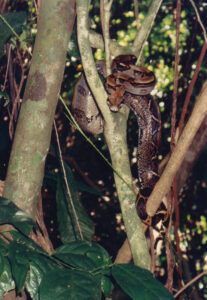 One common belief I had thought to clearly be superstition turned out to be less farfetched than I had once suspected. I didn’t like for the Hacienda Barú workers to kill snakes, but I would tolerate them killing a venomous one. I love the boa constrictors and would get furious whenever a worker killed one. They would always defend themselves saying that boas give birth to terciopelos along with every other species of snake, a belief that I considered to be absolutely ridiculous. The truth is that the campesinos based that idea on observation, but their interpretation of what they were seeing was equivocal. Boas are ovoviviparous, meaning that they give live birth. The newborn babies, 30 to 50 of them, are about as long as my lower leg from my knee down and, surprisingly, they can be white, very dark brown (almost black), or any shade of brown and white in between those two extremes. Campesinos who have witnessed the birth of boas might logically, but incorrectly, deduce that all different species of serpents are born from boas. Of course, boas give birth only to their own species. The babies will grow quickly, shed their skins often as they grow, and all become brown and white with the shade depending on the how long it has been since they last shed.
One common belief I had thought to clearly be superstition turned out to be less farfetched than I had once suspected. I didn’t like for the Hacienda Barú workers to kill snakes, but I would tolerate them killing a venomous one. I love the boa constrictors and would get furious whenever a worker killed one. They would always defend themselves saying that boas give birth to terciopelos along with every other species of snake, a belief that I considered to be absolutely ridiculous. The truth is that the campesinos based that idea on observation, but their interpretation of what they were seeing was equivocal. Boas are ovoviviparous, meaning that they give live birth. The newborn babies, 30 to 50 of them, are about as long as my lower leg from my knee down and, surprisingly, they can be white, very dark brown (almost black), or any shade of brown and white in between those two extremes. Campesinos who have witnessed the birth of boas might logically, but incorrectly, deduce that all different species of serpents are born from boas. Of course, boas give birth only to their own species. The babies will grow quickly, shed their skins often as they grow, and all become brown and white with the shade depending on the how long it has been since they last shed.
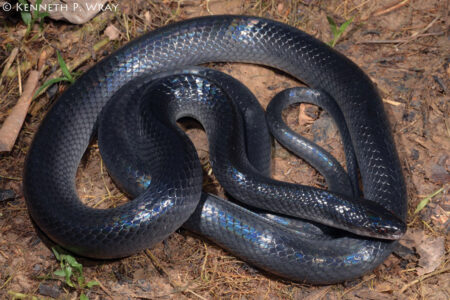 Years ago, we had a huge mussarana snake (Clelia clelia), considerably longer than I am tall, that lived near our house. Since its name is Spanish is zopilota, we called her “Zopy”. Though she occasionally scared people half to death by appearing in unlikely places at inconvenient times, we did nothing to discourage her presence. Among other things mussaranas eat terciopelos, and during the years that Zopy lived with us we never once saw a terciopelo within 200 meters of the house. The worker who lived in a house close to us left Hacienda Barú to work with his uncle, and a new family moved in. I knew that the man of the new family, Luis, who had worked at Hacienda Barú for a couple of years, hated all snakes, and killed venomous and non-venomous alike, despite my orders not to do so. I had a serious talk with Luis about Zopy and made it very clear that I would fire him if anything happened to her. About a month later I was chatting with him while his kids played soccer in their yard.
Years ago, we had a huge mussarana snake (Clelia clelia), considerably longer than I am tall, that lived near our house. Since its name is Spanish is zopilota, we called her “Zopy”. Though she occasionally scared people half to death by appearing in unlikely places at inconvenient times, we did nothing to discourage her presence. Among other things mussaranas eat terciopelos, and during the years that Zopy lived with us we never once saw a terciopelo within 200 meters of the house. The worker who lived in a house close to us left Hacienda Barú to work with his uncle, and a new family moved in. I knew that the man of the new family, Luis, who had worked at Hacienda Barú for a couple of years, hated all snakes, and killed venomous and non-venomous alike, despite my orders not to do so. I had a serious talk with Luis about Zopy and made it very clear that I would fire him if anything happened to her. About a month later I was chatting with him while his kids played soccer in their yard.
The two children laughed and shouted as they kicked the ball back and forth, mocking the professional soccer players they saw on television.
“Gooooal,” shouted Pepe with glee as the ball whizzed past five-year-old Juanito and lodged in the hedge behind him. “That’s three for me and zero for you.”
Juanito bent down and grasped the ball with both hands, pulling hard to pry it from between two hedge branches. Suddenly it broke loose, sending the youngster stumbling backwards a couple of clumsy steps before landing with a “plop” on his backside. At the same moment that the ball slipped free from the branches, a snake, nestled under the hedge, struck, driving its fangs into the soft plastic, close to Juanito’s fingers. The large viper jerked and shook its head, pulling the ball from the boy’s hands and finally freeing its deadly fangs. It recoiled in preparation for a second strike. –
From 30 meters away, Luis and I heard Pepe’s scream “Quitese, Juanito, corra!!!” As we ran to their aid, Juanito was backpedaling on all fours, away from the hedge; the deflated ball rested on the ground near the snake. Luis reached the yard first, grabbed a stick and whacked the snake, killing it with a couple of swift blows.
“Hueputa culebras,” exclaimed the boy’s father. “We’d be better off if they were all dead.” The 1.4-meter terciopelo viper lay dead on the lawn, its velvety diamond pattern shimmering in the sunlight. The boys, though badly shaken, were unharmed. Their mother ran from the house, tears in her eyes, and hugged them close to her bosom.
Zopy had not been seen since shortly after Luis’ family moved in. I strongly suspected that Luis had killed her. “Well Luis, see what happens when you kill mussaranas. You almost lost a son, and as of this moment you can start looking for another job”. Even with that harsh lesson I doubt if Luis quit killing non-venomous snakes.
I’m not a biologist, but I have lived near the rainforest and spent a good deal of my time in the jungle over the last 50 years. I have great respect for campesinos. I am very aware of the fact that even with their generations of accumulated knowledge they can be wrong. You must take what they say into consideration, carefully analyze your own observations, and determine for yourself what to believe.
Jack Ewing was born and educated in Colorado. In 1970 he and his wife Diane moved to the jungles of Costa Rica where they raised two children, Natalie and Chris. A newfound fascination with the rainforest was responsible for his transformation from cattle rancher into environmentalist and naturalist. His many years of living in the rainforest have rendered a multitude of personal experiences, many of which are recounted in his published collection of essays, Monkeys are Made of Chocolate. His latest book is, Where Jaguars & Tapirs Once Roamed: Ever-evolving Costa Rica.
